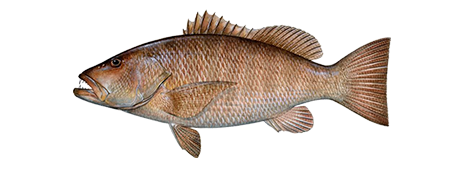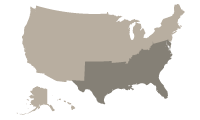
Cubera Snapper
The massive tails of the larger cubera snapper specimens provides extremely powerful resistance for any angler.

Region
South
Catch ease
Hard
Habitat
Bay, Ocean
How to identify a Cubera Snapper
The dorsal fins of the cubera snapper are connected and consist of 10 spines, followed by 14 rays. The anal fin is roundish and consists of eight rays. There are 5-7 gill rakers (not including rudiments) on the lower limb of the first branchial arch. The pectoral fins do not quite reach to the origin of the anal fin. The eyes are dark red and the body ranges from gray to greenish, often tinged with red. Its closest look-alike may be the gray, or mangrove snapper. Like most snappers the gray snapper has more gill rakers on the average (7-9 on the lower limb of the first branchial arch) than the cubera does. The mangrove snapper also is much smaller than a cubera snapper. Another close relative, the red snapper, differs not only in color and size, but in having nine anal rays and 8-10 gill rakers on the lower limb of the first branchial arch. Also, the pectoral fin of the red snapper reaches to or beyond the origin of its anal fin, which is angular, not roundish.
Where to catch Cubera Snapper
The cubera snapper is found throughout the western Atlantic from Florida and Cuba southward to Brazil. It is the giant of all the snappers, attaining weights in excess of 100 pounds and an overall length in excess of four feet. The snapper family Lutjanidae consists of some 250 different species in 25 genera. At least fifteen species are found in the waters of North America, and ten of these species belong to the genus Lutjanus. The following list includes additional details on where to catch this fish:
| Bays and Estuaries |
| Coastal Waters |
| Jetties and Breakwaters |
| Reefs, Wrecks, and Shoals |
| Channel Entrances |
| Deep Shore Water |
| Night Fishing |
| Rocky Sea Floor |
How to catch Cubera Snapper
The cubera snapper ranges in depths from 2-3 ft to 200 ft. It is a very hard fighter and should be targeted using very strong and stout tackle.These fish can be taken with whole live baits, cut baits, or crustaceans. The most popular bait for big cubera snappers is a whole, live lobster. Any angler wanting to target cubera snapper with lobster much first check with state regulations to make sure that lobsters are in season and make themselves aware of any size limit for these lobster baits. Cuberas are an excellent food fish, especially the smaller specimens, but the larger fish have been known to cause ciguatera poisoning. The following are fishing methods used to catch this fish:
Cubera Snapper lures, tackle & bait
The following are lures, tackle or bait that can be used to catch this fish:
